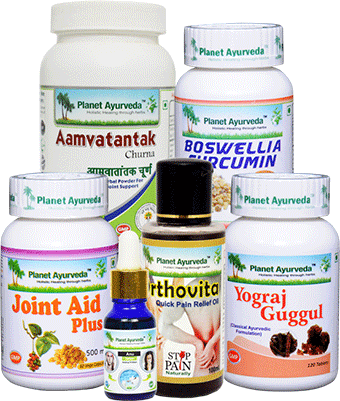Ayurvedic Treatment for Frozen Shoulder

What is Frozen Shoulder?
Frozen shoulder is also known as adhesive capsulitis. It is a condition in which stiffness and pain occurs in your shoulder joint. The signs and symptoms begin gradually, that gets worse with time and resolve within one to three years.
In the case of stroke and mastectomy, the risk of developing frozen shoulder increases as a person is unable to move his/her arm.
In human body, anatomy of shoulder includes ball-and-socket joint that is formed of three bones. These bones are humerus (upper arm bone), scapula (shoulder blade), and clavicle (collarbone). This ball-and-socket joint is surrounded by strong connective tissue known as shoulder capsule. When this shoulder capsule thickens, becomes stiff and tight it leads to a condition known as frozen shoulder.
Frozen Shoulder Stages
Frozen shoulder develops slowly in three stages. Each stage can last for a couple of months.
Stage 1 {Freezing stage} – Due to pain in the shoulder, its movement and motion become restricted. It worse over time and hurt more at night. This stage last from 6 to 9 months.
Stage 2 {Frozen stage} – Diminishing pain occurs in this stage and shoulder starts becoming stiffer and its movement becomes more difficult. It lasts for 4 to 12 months.
Stage 3 {Thawing stage} – Improvement in range of motion of shoulder begins in this stage. This last for 6 months to 2 years.
Frozen Shoulder Causes
The exact cause for Frozen Shoulder is unknown.
In Frozen Shoulder the capsule becomes so thick and tight that it’s unable to move. Synovial fluid is less which keeps joint lubricated as well as bands of scar tissue are formed. The movement is restricted due to these factors.
Other causes:-
- Rotator cuff injury
- Broken Arm
- Stroke
- Recovery from surgery
Systemic diseases that may cause Frozen Shoulder:-
- Diabetes
- Tuberculosis
- Overactive thyroid (hyperthyroidism)
- Underactive thyroid (hypothyroidism)
- Cardiovascular disease
- Parkinson’s disease
Frozen Shoulder Symptoms
- Pain and stiffness which makes movement restricted.
- Dull and hurting pain in the shoulder.
- Sensation in the upper arm.
Risk Factors of Frozen Shoulder
Common risk factors for frozen shoulder are:
- Age: Being over 40 years of age is a risk factor both in men and women.
- Gender: Women is affected more. More than 70% of people with frozen shoulder are women.
- Recent trauma: Surgery or an arm fracture can lead to immobility which causes stiffness of shoulder during its recovery.
- Diabetes: 10 to 20% of people with diabetes develop frozen shoulder, and symptoms may be more severe. The reasons are unclear.
Frozen Shoulder Diagnosis
To diagnose frozen shoulder, a physical examination is done by a doctor. One will check how badly it hurts and how far it can move. During the “active” part of the exam, one will move their shoulder on your own. During the “passive” portion, a doctor will move it for you, and the difference is noted.
Diagnosis is made on a range of motion. A physical examination is enough to diagnose frozen shoulder, but your doctor may also order imaging tests such as X-rays, USG, or MRI to rule out other problems like arthritis or a torn rotator cuff that is also painful condition and limit how far it moved.
Herbal Remedies for Frozen Shoulder by Planet Ayurveda
Planet Ayurveda recommends a pack for frozen shoulder known as Frozen Shoulder Pack. The pack consists of herbal remedies which are a natural formulation, free from chemicals, additives, colors, filers, and yeast etc. This herbal pack maintains healthy body functions. In frozen shoulder, these herbal formulation helps to get relief from pain and stiffness.
Dosage / Usage
- Boswellia Curcumin – 2 capsules should be taken with warm water, two times a day, after meals.
- Joint Aid Plus – 2 capsules should be taken with warm water, two times a day, after meals.
- Aamvatantak Churna – 1 tsp. twice in a day with warm water should be taken half an hour after meals.
- Orthovita Oil – Massage should be done locally with the oil for 10 to 15 minutes twice a day.
- Yograj Guggul – 2 tablets to be taken twice daily with warm water.
- Anu Tailam – Two drops in each nostril at the time of sunrise every morning.
Products Description
1. Boswellia Curcumin
The formulation of these amazing capsules consist of two components, widely known herbs Shallaki (Boswellia serrata) and Curcumin (Curcuma longa). Both the herbs have anti-inflammatory and antioxidant properties. The medicinal value is due to the presence of Boswellic acid in Shallaki and Curcuminoids in Curcumin. These ingredients are extremely helpful in managing the potential complications associated with frozen shoulder.
The use of these capsules are beneficial in boosting the immune system, supporting healthy functioning of joints, increasing blood supply to joint tissue, enhancing the biochemical structure of cartilage, and keeping the cardiovascular system healthy.
2. Joint Aid Plus
Joint aid plus contains standardized extract of Nirgundi (Vitex negundo), Shallaki (Boswellia serrata), Guggul (Commiphora mukul), Sonth (Zingiber officianale), and Ashwagandha (Withania somnifera).
Besides this, it acts as a great source of dietary nutrition for the bones and joints in the body. Hence, it is an effective formula for frozen shoulder.
3. Aamvatantak Churna
It is 100% natural product that consists of different herbs like- Ashwagandha (Withania somnifera), Methi (Trigonella foenum graecum), Haridra (Curcuma longa), Suranjaan (Colchicum automnale), Gorkhmundi (Sphaeranthus indicus), and Sonth (Zingiber officinale).
All the herbs are mixed which have different constituents and every constituent has different properties like anti-inflammatory, analgesic, and antioxidant that provides relief from symptoms like pain and swelling.
4. Orthovita Oil
This herbal oil helps to support healthy bones, joints, and muscles Supports overall body strength and physical features. It is a purely natural formula. The oil is absolutely free from chemicals, extra colors, additives, fillers and yeast etc. It is very effective in case of frozen shoulder. Orthovita oil removes stiffness, pain in shoulder and relaxes shoulder joint and muscles.
5. Yograj Guggul
It is a tablet which consist of ingredients are – Shudh Guggulu (Commiphora mukul), Chitraka (Plumbago zeylanica), Jeeraka (Cuminum cyminum), Pippali (Piper longum), Amalaki (Emblica officinalis), Ela (Elettaria cardamomum), Mustaka (Cyperus rotundus), Ardraka (Zingiber officinale) and Haritaki (Terminalia chebula).
6. Anu Tailam
Anu tailam is one of the oils prepared by Planet Ayurveda as per classical texts which is used for administered in nostrils in the form of drops (nasya). This herbal remedy provides strength to the nerves and nourishes all the five sense organs. It consists of vata and kapha pacification effects which helps in preventing degeneration of the cells and alleviates free radicals from the body. As in frozen shoulder there is increase in vata and kapha dosha that leads to restriction of the shoulder movement due to stiffness and pain. By giving nasya with anu thailam it helps in alleviation of vata and kapha dosha thus aids in reducing the condition of frozen shoulder. Ingredients like Chandana (Santalum album), Aguru (Aquilaria agalocha), Patra (Cinnamomum Tamala), The bark of Darvi (Sida cordifolia), Prapaundarika (Nymphaea lotus), Sookshma Ela (Elettaria cardamomum) is used in this formulation.
The herbs used in formulation of these tablets are anti-inflammatory in nature and helps in reducing pain. These tablets maintain overall symptoms associated with frozen shoulder.
To buy Frozen Shoulder Pack, please visit store.planetayurveda.com/products/frozen-shoulder-pack.
Frozen Shoulder Exercises
Pendulum stretch
Do this exercise. In this exercise first, relax your shoulders. Stand and lean, allow the affected arm to hang down slightly. Make your arm to Swing in a small circle – about a foot in diameter. Repeat this 10 times in each direction, once a day. As you see improvement in symptoms, increase the diameter of your swing, without any force. When you’re ready for more, increase the stretch by holding a light weight (three to five pounds) in the swinging arm.
Towel stretch
Hold one end of taking a three-foot-long towel, hold it from one end. Took behind your back and grab the opposite end with your other hand. In a horizontal position hold the towel. Use your healthy arm to pull the affected arm upward and stretch it. An advanced version of this exercise can also be done. In this the towel has to be draped over your healthy shoulder. Hold the towel bottom with the affected arm and pull it toward the lower back with the unaffected arm. Repeat this 10 to 20 times a day.
Cross body stretch
You can do this in sitting or standing position. Use your healthy arm to lift your affected arm at the elbow, and bring it up across your body or shoulder, exert a gentle pressure to stretch the shoulder. Hold the stretch for 15 to 20 seconds. Repeat this 10 to 20 times per day.




